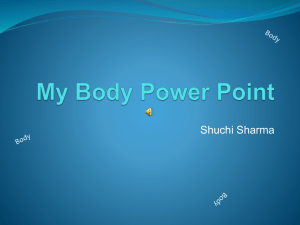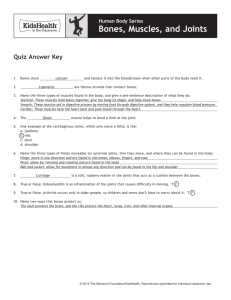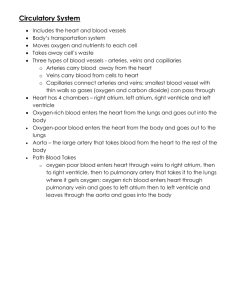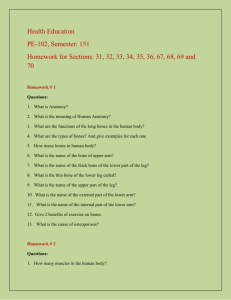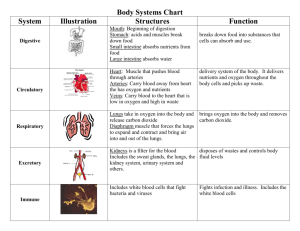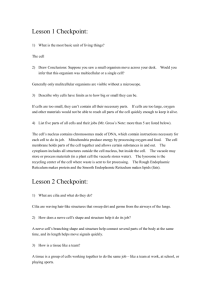The Human Body
advertisement
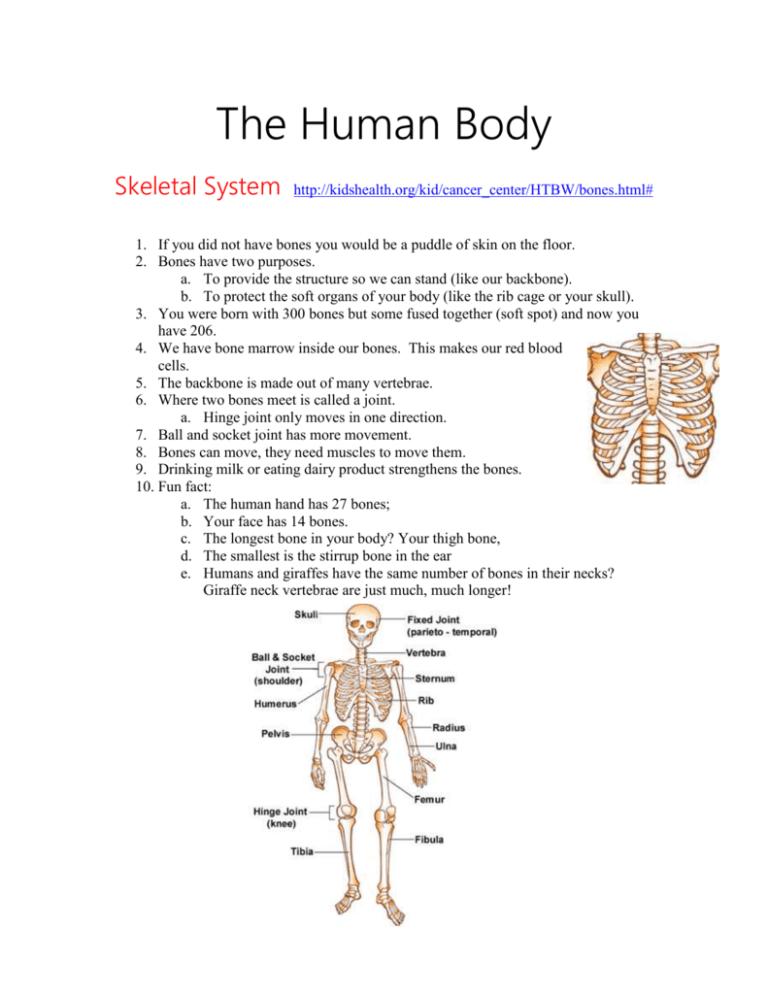
The Human Body Skeletal System http://kidshealth.org/kid/cancer_center/HTBW/bones.html# 1. If you did not have bones you would be a puddle of skin on the floor. 2. Bones have two purposes. a. To provide the structure so we can stand (like our backbone). b. To protect the soft organs of your body (like the rib cage or your skull). 3. You were born with 300 bones but some fused together (soft spot) and now you have 206. 4. We have bone marrow inside our bones. This makes our red blood cells. 5. The backbone is made out of many vertebrae. 6. Where two bones meet is called a joint. a. Hinge joint only moves in one direction. 7. Ball and socket joint has more movement. 8. Bones can move, they need muscles to move them. 9. Drinking milk or eating dairy product strengthens the bones. 10. Fun fact: a. The human hand has 27 bones; b. Your face has 14 bones. c. The longest bone in your body? Your thigh bone, d. The smallest is the stirrup bone in the ear e. Humans and giraffes have the same number of bones in their necks? Giraffe neck vertebrae are just much, much longer! Digestive System http://kidshealth.org/Search01.jsp 1. Digestion begins even before you take a bite. Thinking about food makes your Silva begins to form in your mouth. 2. The mouth, esophagus, stomach, large and small intestine, and rectum are all part of this system. 3. Acid in your stomach breaks down the food. 4. Fun Facts: a. Your intestines are at least 25 feet in an adult. b. Food sloshing in the stomach can last 3-4 hours. c. It takes 3 hours for food to move through the intestine. d. Food drying up and hanging out in the large intestine can last 18 hours to 2 days! e. In your lifetime, your digestive system may handle about 50 tons!! Muscular System http://kidshealth.org/Search01.jsp 1. 2. 3. 4. 5. You have over 630 muscles that move you. Muscles can't push. They pull. Muscles contract and then relax. Muscles work in pairs. There are two kinds of muscles: Voluntary - when you have to think about it like swinging a bat? Or clapping your hands? Involuntary - when you don’t think about it like your heart pumping, blinking you eyes, or breathing. 6. Fun Facts: a. You have over 30 facial muscles, which create looks like surprise, happiness, sadness, and frowning. b. Eye muscles are the busiest muscles in the body. Scientists estimate they may move more than 100,000 times a day! c. The largest muscle in the body is the gluteus maximus muscle in the bum. Circulatory System 1. 2. 3. 4. 5. http://kidshealth.org/kid/htbw/heart.html# Your heart is the size of your fist. It has four chambers (2 ventricles and 2 atrium). Your heart acts like a pump. It pumps 70 times a minute if at rest, faster when active. It pumps the blood through arteries and veins to all parts of your body. 6. 7. The smallest blood vessel is called a capillary. 8. The blood carries oxygen to your body from the lungs. 9. Then it takes the CO2 from your body and give it to the lungs to get rid of it 10. This process is called circulation. 11. Fun facts: a. The body of an adult contains over 60,000 miles of blood vessels! b. Strung together end-to-end, your blood vessels could circle the globe 2 1/2 times! c. An adult's heart pumps nearly 4000 gallons of blood each day! d. Your heart beats some 30 million times a year! e. A "heartbeat" is really the sound of the valves in the heart closing. It makes a lub-dub sound. Respiratory System http://kidshealth.org/Search01.jsp 1. You have two lungs. 2. The lung on the left side of your body is a bit smaller than the lung on the right. This extra space on the left leaves room for your heart. 3. Our lungs are protected by your rib cage, which is made up of 12 sets of ribs. 4. A dome-shaped muscle called the diaphragm is what makes you breathe. 5. The lung is pink and it is connected to the trachea or the windpipe. 6. The pipes get smaller and smaller until the can give the air to the blood. The smallest tube is called an alveoli and we have 600 million of them. 7. They give the oxygen to the capillaries and they are so small only one blood cell can go through at a time. 8. As you breathe in you take in oxygen. As you breathe out you exhale Carbon dioxide (CO2). 9. You lungs also help in talking. It brings in air that go over the vocal cords causing them to vibrate and a sound is made. 10. Smoking hurts the lungs and turn them black and hard, so that they don’t work anymore. Nervous System http://kidshealth.org/Search01.jsp 1. The nervous system controls everything you do, including breathing, walking, thinking, and feeling. 2. The nervous system made up of your brain, your spinal cord, and an enormous network of nerves that thread throughout your body. 3. The brain is the control center of the nervous system. 4. The brain is made of more than 10 billion nerve cells and over 50 billion other cells and weighs less than 3 pounds! 5. The brain has different parts for different jobs. One parts is for thinking and solving problems and another part controls the involuntary jobs like breathing and moving the food through your body. 6. Nerves carry messages to the brain, like a telephone wires and they usually go through the spine cord. 7. Thoughts travel at a nanosecond. 8. Fun facts: a. A newborn baby's brain grows almost 3 times in course of first year! b. Humans have the most complex brain of any critter on earth! c. Your brain is divided into two sides. The left side of your brain controls the right side of your body; and, surprise, the right side of your brain controls the left side of your body. Urinary System http://kidshealth.org/Search01.jsp 1. Is made up of the kidneys: two bean-shaped organs that filter waste from the blood and produce urine. 2. ureters: two thin tubes that take pee from the kidney to the bladder. 3. bladder: a sac that holds pee until it's time to go to the bathroom. 4. urethra: the tube that carries urine from the bladder out of the body when you pee 5. Fun Facts: a. your kidneys are the same shape and color of a kidney bean. b. Your kidneys have about a million structures that filter out liquids and wastes. c. About 440 gallons of blood flow through the kidneys each and every day!

